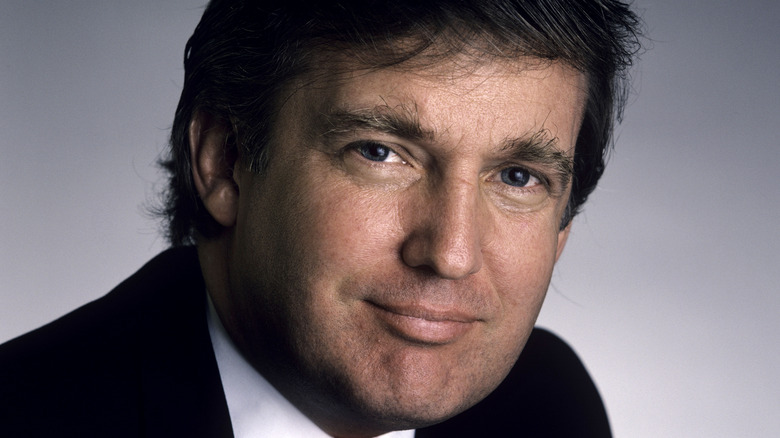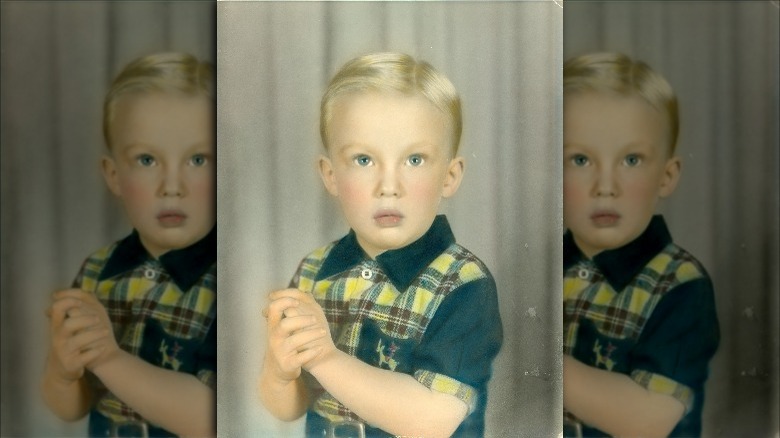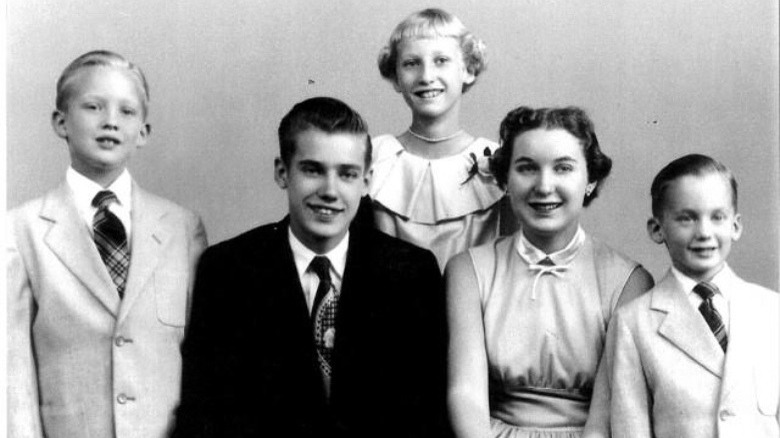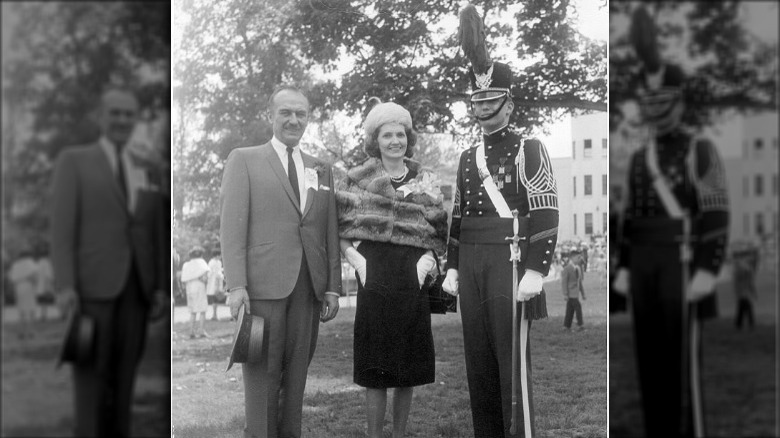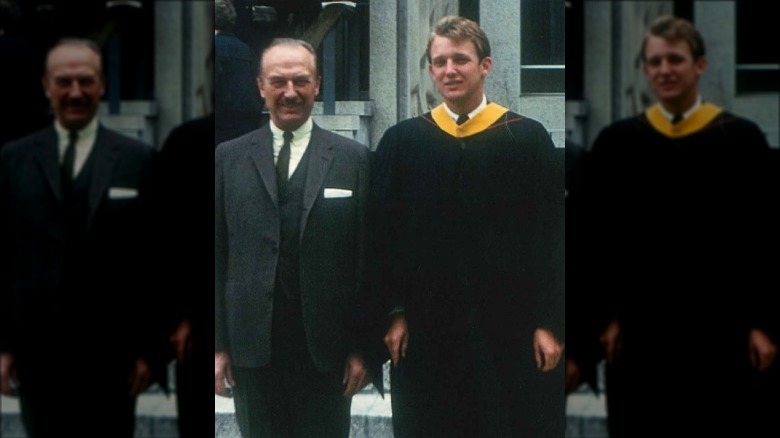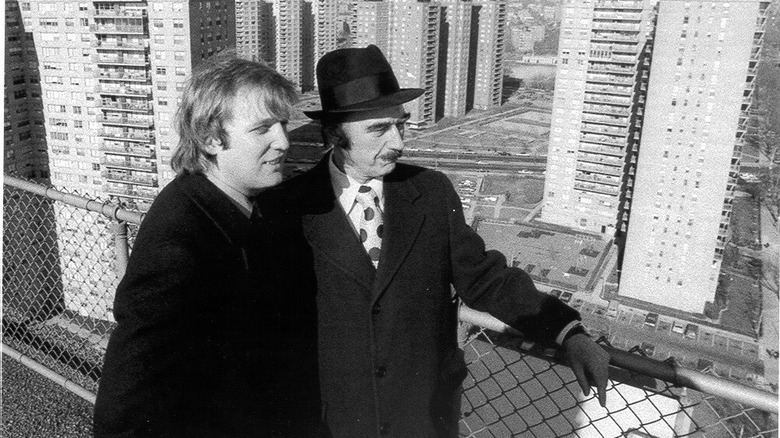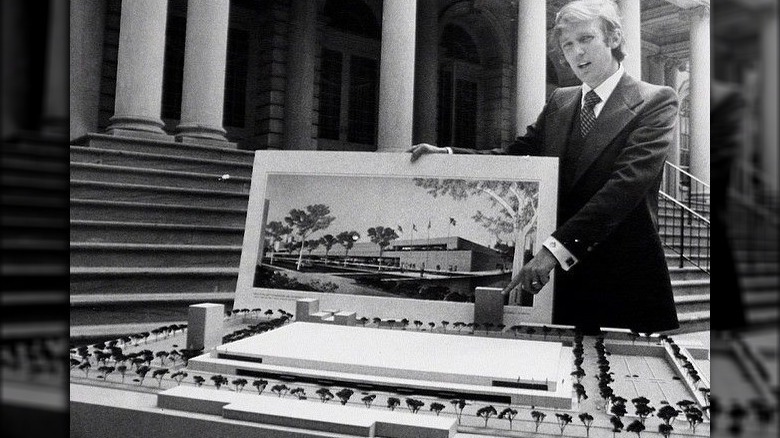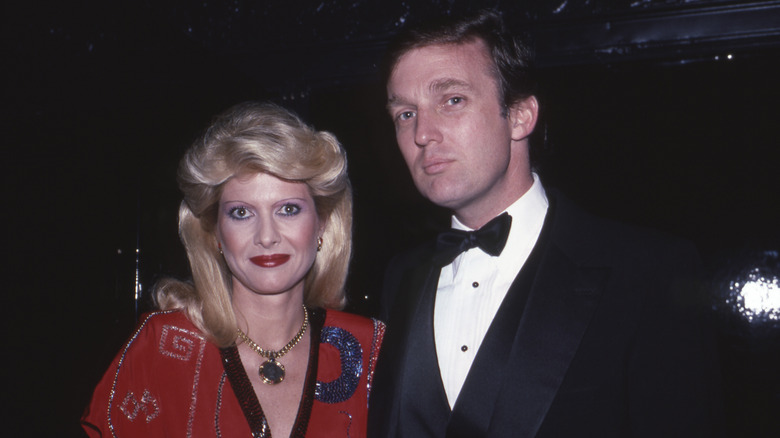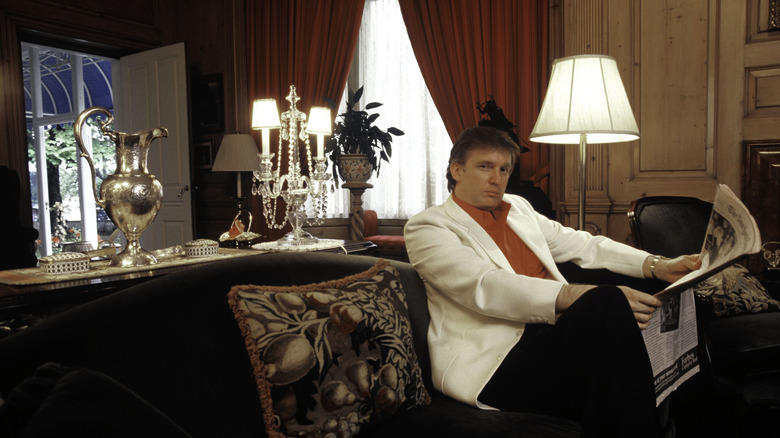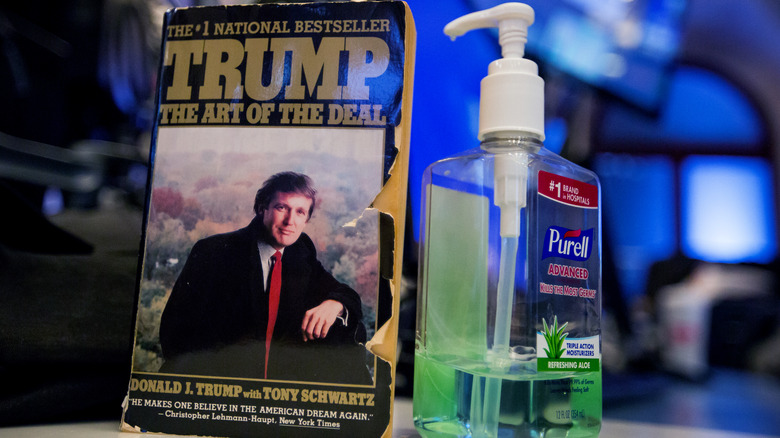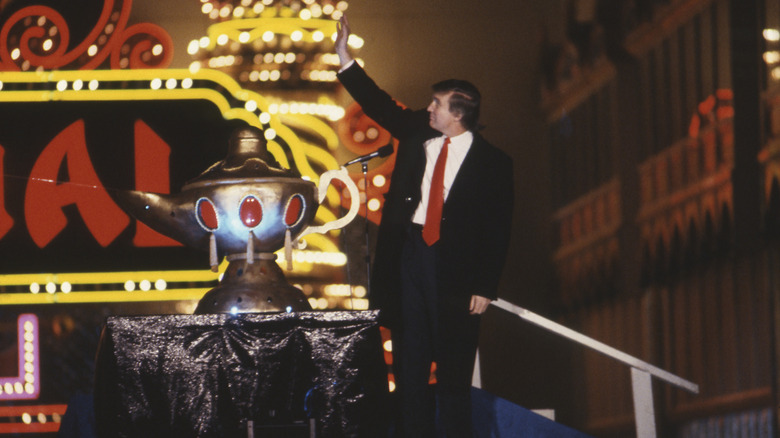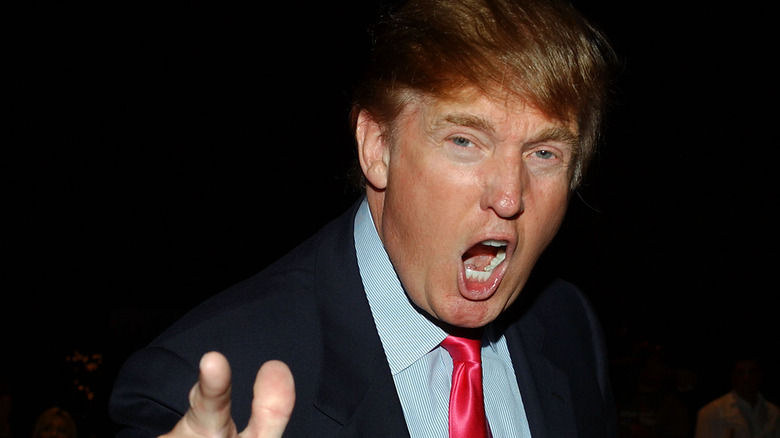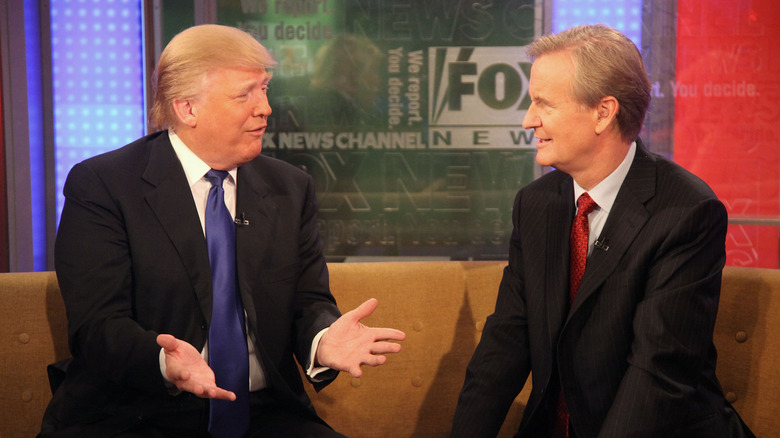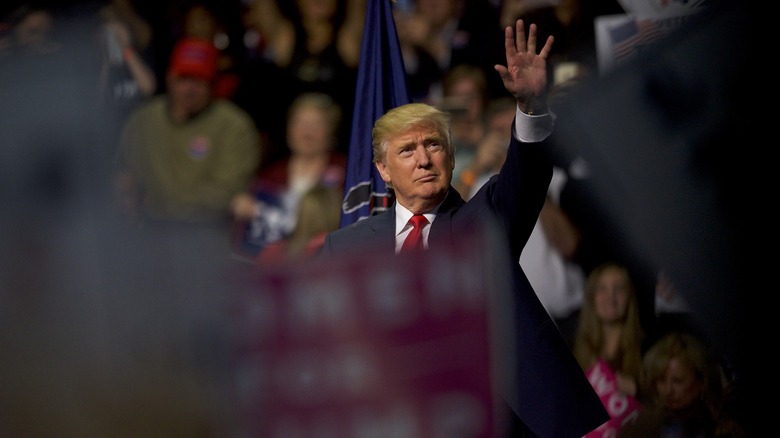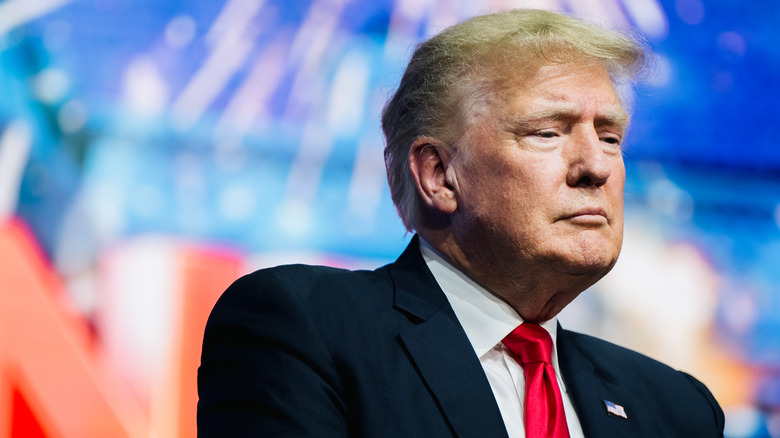The Transformation Of Donald Trump From Childhood To 75 Years Old
Donald Trump has been in the spotlight four decades since he became president of his family's real estate company when he was in his 20s. He became popular in the 1970s and 1980s as an icon of the so-called "American Dream." His 1984 GQ magazine cover feature became a sensation, partly because it promised to share the secret to Trump's "success." Five years later, he would appear on the cover of Time magazine, which teased that "this man may turn you green with envy."
Trump became a celebrity because he made billions, and Americans wanted to know how he did it. While he did, indeed, run The Trump Organization from an early age, he also inherited a well-established real estate empire from his father, who founded the company with his mother back in the 1920s. As The New York Times pointed out, Trump was born filthy rich, even though he has long pushed the narrative that his father gave him a $1 million loan, and he turned it into a multi-billion dollar enterprise.
In the early 2000s, Trump became an even bigger celebrity when he showed off his natural showmanship as the host of NBC's "The Apprentice." The role put Trump back on the map after a decade marked by divorces and business bankruptcies, helping him carve a path that led all the way to The White House. Keep scrolling to check out the eventful transformation of Donald Trump from rich, troublesome kid to former president of the United States.
Donald Trump was a millionaire by age 8
Donald Trump was born to Mary Anne MacLeod and Fred Trump, a real estate investor whose property empire made his fourth child a millionaire by the time he turned 8, according to The New York Times. Donald grew up in Jamaica Estates, Queens, New York, in a house boasting 23 rooms and white columns along the portico, as The Washington Post pointed out. The family owned the neighborhood's first color TV at a time when most people couldn't even afford black-and-white ones, according to Politico.
Additionally, Donald and his siblings — Maryanne, Fred Jr., Elizabeth, and Robert — were also pretty fond of their basement, where they had a model train set that attracted plenty of friends to their home. It was "just splendid, trains going through tunnels and over buildings and all around," Mark Golding, a childhood friend of Donald's, told Politico, adding it was "a lot bigger than anything I had ever seen." As they played, a domestic worker would give them sandwiches "with the crusts cut off," the report detailed.
Even though he was worth $200,000 by the age of 3, per The New York Times, Donald has always denied being the product of his privilege, contending his father never spoiled him and, instead, encouraged him to carve out his own destiny. "That's why I'm so screwed up, because I had a father that pushed me pretty hard," he wrote in "Think Big" (via "Trump on the Couch").
Health issues prevented Mary Trump from caring for her young children
Donald Trump was 2 years old when his youngest sibling, Robert Trump, was born. Mary Anne Trump had complications with this birth that led to severe hemorrhaging, according to Politico, and had to be rushed to the hospital, as a result. She underwent a hysterectomy, which led to further complications and an abdominal infection that put Mary Anne's life on the line. "My father came home and told me she wasn't expected to live, but I should go to school and he'd call me if anything changed. That's right — go to school as usual!" Maryanne Trump, Trump's eldest sister, told Gwenda Blair, author of "The Trumps: Three Generations of Builders and a Presidential Candidate." With his mother in and out of the hospital for emergency surgeries, Donald and his siblings were largely left in the care of their busy father, per The Guardian.
Mary Anne recovered and returned to her place as homesteader and entertainer of the family. "When the lights went up, she was the star," Maryanne told Blair of her mother. Donald also holds this view of his late mother, having argued that he inherited his showmanship from her, Vanity Fair's Marie Brenner wrote in 1990. "My mother had a sense of the grand. I can remember her watching the coronation of Queen Elizabeth and being so fascinated by it," he said. "My father had no interest in that kind of thing at all."
Donald Trump's parents sent him to a boarding school over his poor behavior
Donald Trump gave his parents frequent headaches for starting trouble at school, per The Washington Post. While at Kew-Forest School, Trump punched a teacher, giving him a black eye "because I didn't think he knew anything about music," per The New York Times. In an effort to instill discipline in his son, Trump's real-estate mogul father sent him to the New York Military Academy in 1959 when he was 13 years old. Trump never denied this behavior. "As an adolescent, I was mostly interested in creating mischief. I liked to stir things up, and I liked to test people," Trump wrote in "The Art of the Deal" (via The Washington Post).
During the 2016 presidential campaign, Trump told The Washington Post that he was one of the academy's best students. "I did very well under the military system. I became one of the top guys at the whole school." However, Trump reportedly ordered his then-lawyer Michael Cohen to "threaten" academy officials to keep them from releasing Trump's school records, The Washington Post reported in 2019.
Some of the trustees on the NYMA board intended to release the transcripts, but school officials kept them from doing so. Superintendent Jeffrey Coverdale told The Post he was "given directives" to move them to a part of campus that would keep them safe, adding that it was "the only time I ever moved an alumnus's records."
Donald Trump obtained five draft deferments while in college
In 1966, two years after graduating from the New York Military Academy and enrolling at Fordham University, a private Jesuit institution, Donald Trump transferred to the prestigious Wharton School of the University of Pennsylvania, per The Observer. He graduated in 1968, a year the United States rang in with the "Tet Offensive," a series of attacks that marked a milestone in the bloody and unpopular Vietnam War, per History.
The number of soldiers the country sent to Vietnam peaked in 1969 at nearly 550,000 men, per History. Throughout his college years, Trump received four draft deferments to finish his education, according to Business Insider. After graduating, Trump received a fifth and final deferment that guaranteed he would see no combat in his lifetime. In 1968, he was diagnosed with bone spurs in his feet, a diagnosis that made him unfit for military service, per The New York Times. Prior to these spurs, Trump had a "perfect" health bill, supported by his athletic background in school, The Times detailed. The condition later improved on its own, Trump said.
Even though he avoided being drafted, Trump feels like he was in the military. According to The New York Times, Trump said in 2015 his experience at the New York Military Academy, a prep school, gave him "more training militarily than a lot of the guys that go into the military."
Donald Trump became president of his father's business shortly after college
After graduating from Wharton, Donald Trump was set to succeed his father in business, even though he wasn't the eldest son. That's because Fred Trump Jr. defied his parents' wishes and began studying to become an airplane pilot in the mid-1960s, according to The Washington Post. While still in college, Donald was already looking over the family company's reports to learn the business, so he couldn't understand his brother's aspirations. "You're wasting your time," Trump recalled telling him, per The Post.
With Fred Jr. shying away from the family operations, Donald stepped in. Just a few years after leaving Wharton, he was put in charge of E. Trump & Son, the company founded by his paternal grandmother, Elizabeth Trump, and her son, Fred Trump Sr., in 1923, per The Economist. In the early 1970s, his father made Donald president of the company after he decided to leave the position to become chair of the board, according to Gwenda Blair's book "Donald Trump: The Candidate." It wouldn't be long before Donald made one of his first major business decisions: renaming the company The Trump Organization.
While Donald's career soared, his brother's health deteriorated as he sunk deeper into alcoholism, an illness that, as the family believes, caused the heart attack that led to his death in 1981, at just 42 years old. According to The Post, Trump expressed some regret "having put pressure on him."
In 1973, The Trump Organization was sued for discriminating against Black renters
In the early days of Donald Trump's leadership of his father's empire, his organization was sued by the U.S. Justice Department in 1973 for frequent violations of the Fair Housing Act. According to a report originally published by The Village Voice in 1978, the complaint stated that the organization discriminated against potential Black renters. The report cites both superintendents and rental agents who had been instructed to reject applications based on race. One mentioned Fred Trump, the report detailed.
Donald defended his and his organization's actions publicly, arguing they were victims of a "nationwide drive to force owners of moderate and luxury apartments to rent to welfare recipients." Donald kept going, declaring that he would not fall for the scheme. "We are not going to be forced by anyone to put people ... in our buildings to the detriment of tenants who have, for many years, lived in these buildings, raised families in them, and who plan to continue to live there. That would be reverse discrimination," he said, according to the publication.
The lawsuit was the first of a long list of legal troubles that would plague The Trump Organization and its leader, most of which involve accusations of fraud and racketeering, as the BBC News detailed. Nevertheless, his business earned Donald the status of billionaire. According to Forbes, the former president is worth about $2.4 billion, most of which is thanks to his real estate empire.
Donald Trump married for the first time in 1977
Donald Trump said "I do" for the first time in April 1977, when he married Ivana Zelníčková, a Czech model. Ivana became an American citizen 11 years later, per The Lewiston Journal. "I'm very proud of my wife. I'm very proud of my country and that's where a great woman should be. Now they're both matched up perfectly," Donald said after her naturalization ceremony. Together, they had three children: Donald Jr., born in 1977, Ivanka, born in 1981, and Eric, born in 1984.
The couple separated in 1990 when Donald's affair with Marla Maples, a model 17 years his junior, hit the tabloids in 1989, according to People. In 1991, they settled their contentious divorce, which determined that Ivana should get $14 million plus some property, The New York Times reported at the time. The whole ordeal was bad for Donald's popularity and brought shame to his family. "What kind of son have I created?" Donald's mother, Mary Anne Trump, is said to have asked Ivana at the time, according to Vanity Fair.
Donald and Marla continued to date off and on until 1993, when she found out she was pregnant, an event she characterized as "the greatest unplanned surprise of all," per People. The pair married in December of that year, when daughter Tiffany was 2 months old, as The Philadelphia Enquirer reported. The marriage, however, didn't last. The couple separated four years later and divorced in 1999.
Donald Trump unveiled the first Trump Tower in 1983
In the late 1970s, Donald Trump began construction on the ambitious Trump Tower, a project that was meant to symbolize "Mr. Trump's grand vision and ability to achieve tremendous success with everything he touches," per the Trump Tower website. Trump purchased the property when Bonwit Teller — a store designed in 1929 with the abundance of bronze, hammered aluminum, and tinted glasses embraced by the Art Deco style of the time — closed its doors at Fifth and 56th.
Per The New York Times, the building included two limestone relief sculptures atop the facade, which Trump vowed to preserve and donate to the Metropolitan Museum of Art. But, instead, he had his men destroy them, contending they were "without artistic merit" and too expensive to remove, per The Times. There was some commotion at the time, with The Times calling for governmental actions to prevent future historical losses. "Evidently, New York needs to make salvation of this kind of landmark mandatory and stop expecting that its developers will be good citizens and good sports," the publication argued.
Trump went on to open the doors to his first Trump Tower in 1983. When in New York, he still stays at the gilded penthouse. Among those who have lived in the famed building include Michael Jackson, Johnny Carson, and Liberace, per Bloomberg. The building also serves as the headquarters for The Trump Organization, a testament to its importance to the Trump brand.
In 1987, Donald Trump became a best-selling author
Donald Trump became a true household name with the release of his first book in 1987, co-written with journalist Tony Schwartz. Combining elements of memoir and advice on deal making, "The Art of the Deal" shot to the very top of The New York Times Best Sellers List, where it remained for a total of 48 weeks, according to The New Yorker. The success of the book, which has sold more than 1 million copies, helped take Trump's name beyond New York City's borders, per the publication. "Tony created Trump. He's Dr. Frankenstein," said journalist Edward Kosner, the publisher and editor of New York Magazine, where Schwartz worked at the time.
Indeed, Schwartz feels strongly about the role he played in the book's success, calling the project "the greatest regret of his life," according to CBS News. "Trump is not only willing to lie, but he doesn't get bothered by it, doesn't feel guilty about it, isn't preoccupied by it. There's an emptiness inside Trump," Schwartz told CBS, adding that he did it for the money. Schwartz received $250,000 up front plus half its royalties, CBS detailed.
According to Timothy L. O'Brien's "TrumpNation: The Art of Being The Donald," Trump was encouraged to take on the project by media tycoon S.I. Newhouse following the success of his GQ feature that delved into his story as a businessman.
Donald Trump's first bankruptcy came amid his first divorce
Financially speaking, 1991 was a bad year for Donald Trump. In the midst of his multi-million dollar divorce settlement with Ivana Trump, one of Trump's businesses filed for bankruptcy that year as well. That July, the casino formerly known as Trump Taj Mahal in Atlantic City, New Jersey, filed for Chapter 11 in an effort to reduce its debt, The New York Times reported at the time.
As NBC News pointed out, it was the first bankruptcy on a list of six. The following year was even worse for Trump. Three other businesses met the same fate as the Taj Mahal: Trump Castle Hotel & Casino and Trump Plaza, both in Atlantic City, and the Plaza Hotel in Manhattan in 1992. More than a decade later, Trump Casino Holdings in Atlantic City filed for bankruptcy, followed by Trump Entertainment Resorts in 2009.
Over the years, Trump has argued that he has used Chapter 11 to his advantage. Going to court saved his businesses, allowing them to continue to operate and rake in even more debt, according to The New York Times. "Out of hundreds of deals that I've done, hundreds, on four occasions I've taken advantage of the laws of this country, like other people. Virtually every person that you read about on the front page of the business sections, they've used the law," Trump said during a presidential debate in August 2015, as Politico pointed out.
Donald Trump finds celebrity status again with 'The Apprentice'
The 1980s made Donald Trump a star, but the 1990s recanted that status amid his divorces and business failings. Though Trump's popularity among the general public may have plunged, he continued mingling with New York City's most influential circles. In 2002, Trump met Mark Burnett, a television producer behind the successful reality show "Survivor," per The New Yorker. At the time, Burnett was in the process of pitching a sort of urban "Survivor" in which contestants fought each other for a job.
Trump enters. In 2004, NBC launched Season 1 of "The Apprentice" with Trump as its host, promoting the real-estate developer as the image of success, as The New Yorker described. The show was a hit, helping popularize Trump and his catchphrase, "You're fired!" The 14 years he spent hosting "The Apprentice" not only made him $214 million, but also transformed him into a celebrity, according to The Washington Post. The show, however, did more than just earn Trump a star on the Hollywood Walk of Fame — it helped bring him back from the brink of financial disaster, The Post argued.
Katherine Walker, who produced the first five seasons of "The Apprentice," agrees. "I don't think any of us could have known what this would become, but Donald would not be President had it not been for that show," she told The New Yorker, whose author characterized Burnett's transformation of Trump as "his chief legacy."
Donald Trump became a family man again — and a potential politician
In 2005, Donald Trump married Slovenian model Melania Knauss at Mar-a-Lago in Palm Beach, Florida, before the eyes of 350 guests, according to The Washington Post. The crowd included both entertainers and politicians, namely the Clintons, the Patakis, the Giulianis alongside P. Diddy, Heidi Klum, and others, the report detailed. According to The New York Times, Trump and Knauss were introduced back in 1998, when he was still officially married to his second wife, Marla Maples. In March 2006, the couple welcomed their only child, Barron William, People reported.
During this time, Trump continued to pump out books, releasing four titles just in 2006 and three in 2011, with several others prior and in between. According to On The Issues, his 2011 book "Time to Get Tough: Making America #1 Again" was meant as a preamble to his 2012 presidential election bid, an interest he had previously expressed in 2000. At this time, Trump also gave the public a sneak peek of the campaign he planned on running when he brought the conspiracy theories surrounding former President Barack Obama's citizenship to the mainstream, CNBC noted.
Trump ultimately decided against running because he didn't want to give up "The Apprentice," according to Business Insider. "Am I the only guy in history at [No.] 1 in the polls who got out? Am I f***ing crazy?" Trump asked himself, according to the book "Double Down: Game Change 2012."
Donald Trump stamped his name in U.S. history in 2015
On June 16, 2015, Donald Trump announced his bid for the presidency. "Our country needs a truly great leader. And we need a truly great leader now ... We need somebody that can take the brand of the United States and make it great again," he said. In his speech, he also declared that Mexican immigrants were "bringing drugs" and "crime" into the country and that they were "rapists," he can he heard saying in a video shared by Time. His remarks prompted NBC to cut ties with Trump, ending his time on "The Apprentice" for good, Slate reported.
It was the beginning of a highly polarizing campaign that proved successful. On November 8, 2016, Trump was declared the 45th president of the United States after defeating former Secretary of State Hillary Clinton, a result that defied nearly all polls ahead of the election, as Wisconsin Public Radio pointed out. On the day of the election, The New York Times estimated Clinton had a 85% chance of winning, using a model that had never put Trump ahead.
Trump's victory was a true defeat for the establishment all around. The TV host-turned-president went on to oversee four years marked by a seemingly endless string of controversies, Time described. Trump lost the 2020 election to Joe Biden amid the COVID-19 crisis — which many believe he mishandled — that ravaged the country and much of the world.
Donald Trump could run again in the 2024 presidential election
After losing the election to President Joe Biden, Donald Trump embarked on a crusade to convince Americans he had been a victim of widespread voter fraud. In the month that followed, Trump took a series of legal actions to challenge the results, all of which were rejected by state and federal judges, per The Washington Post. But that didn't deter Trump, whose efforts culminated on January 6, 2021, when he held a "stop the steal" rally to urge followers to "take back our country," ABC reported. Shortly after, his supporters stormed the U.S. Capitol during certification of election results, causing the death of five people, including a police officer, an event that The Washington Post described as "one of America's ugliest days."
Following the attacks, the House of Representatives charged Trump with "incitement of insurrection" and impeached him a second time, making him the only president in U.S. history to be impeached twice, NPR reported. The Senate acquitted him in February, per The Guardian. Nevertheless, Trump still faces a series of legal actions regarding his actions as president and alleged business wrongdoings, CNN noted.
There has been speculation Trump might run in 2024. He hinted at it on Lara Trump's podcast "The Right View" (via the Independent), claiming he wants to hold a rally "relatively soon just to let everybody know that there's hope in the future." Given his unpredictable nature, what Trump does next remains to be seen.

